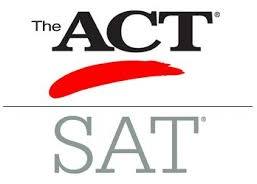SAT vs ACT
Having studied in different countries and following different curriculum, it becomes difficult for universities to come to a common platform to decide which student to be admitted in the college and whose application to be denied. To measure how ready a high school student is for the college, and to provide a common data point for the universities which is used to compare all applicants, certain exams are conducted. The most common of them are the SAT and the ACT.
Whether a particular country accepts both SAT and ACT scores depends on the program, specialization and the university. It cannot be generalized in all cases. Undergraduate applicants must make it a point to thoroughly check a particular university’s requirements to find out whether both the tests are accepted or only one of them is accepted. Example, The University of Oxford accepts both ACT and SAT scores, while the NUS Singapore requires SAT and SAT subject test scores from candidates who have studied class 12th from a board other than CBSE or ICSE. The details, similarities and the major differences for both the tests are discussed below.
SAT - The Scholastic Assessment Test is an entrance exam used by most colleges and universities to make admission decisions. This is a multiple choice paper created and administered by the College Board.
ACT – The American College Test is another standardized test to determine a high school graduate’s preparation for college level.
These tests are perceived to be similar in nature by many but that is not the case in entirety. Both the tests are different from each other in a lot of areas like the subject matter of the test, the duration, the conducting bodies and so on. But before we discuss the differences between the two, let’s see how similar they are.
- Both are nationally recognized standardized tests and common admission requirements for US schools.
- Both measure students’ proficiency in various critical skills such as problem solving, reading comprehension and contain similar sections in a pre-determined order.
- No negative marking for wrong answers. Only the right answers are scored.
- Both tests offer an optional essay section, whose marks are not counted towards the total score.
- Contain entirely passage based reading and writing questions in English.
The paper pattern of both the tests looks something like this:
|
|
SAT |
ACT |
|
Duration |
Without Essay – 3 hours With Essay – 3 hours 50 minutes |
Without Essay- 2 hrs 55 minutes With Essay – 3 hours 35 minutes |
|
Sections |
Reading Writing and language Math – no calculator Math – Calculator Essay (optional) |
English Math Reading Science Writing (optional) |
|
Questions per Section |
Reading – 52 Writing and language- 44 Math – no calculator- 20 Math – Calculator- 38 Essay (optional) - 1 |
English - 75 Math - 60 Reading - 40 Science - 35 Writing (optional) – 1 |
|
Time per Section |
Reading – 65 min Writing and language- 35 minutes Math – no calculator – 25 minutes Math – Calculator – 55 minutes Essay (optional) – 50 minutes |
English – 45 minutes Math – 60 minutes Reading – 35 minutes Science – 35 minutes Writing (optional) – 40 minutes |
|
Additional info |
|
|
Other than the test pattern, there are other significant ways in which these tests differ, which are mentioned below:
|
|
SAT |
ACT |
|
Test Style |
Mostly evidence and context based with the motive of a focus on real world situations and multi step problem solving. |
Mostly straightforward. Questions may be long but are comparatively easier to decipher. |
|
Focus area |
Major focus on Vocabulary, with many questions designed to take several reads to understand. |
Major focus on Science section designed to test reading and reasoning skills and comparatively higher level Math than the SAT. |
|
Scoring |
Math and Evidence Based Reading and Writing are each scored on a scale of 200 to 800. Composite score ranges from 400 to 1600. |
English, Math, Reading and Science scores range from 1 to 36. Composite score ranges from 1 to 36. |
|
Ease of Questions |
|
|
|
Aid for Math section |
|
|
|
Conducted when? |
7 times in an year March or April; May; June; August; October; November; December |
7 times in an year February; April; June; July; September; October; December |
|
When to register? |
About 4 weeks before the test date |
About 5 to 6 weeks before the test date |
|
Who should take the test? |
A student who is:
|
A student who is:
|
|
Official Website |
www.collegeboard.com |
www.act.org |
To make the final decision of which test is to be taken, you can always give a mock test and check your scores. Also check the parameters which match your personality and accordingly take the decision.



